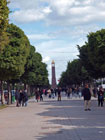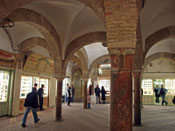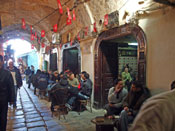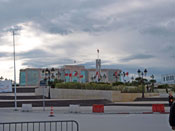FRANKFURT | CASABLANCA | ROAD TO FEZ | FEZ | ROAD TO ERFOUD | ONWARD TO OUARZAZATE | ROAD TO MARRAKECH | MARRAKECH | TUNISIA | CARTHAGE | DOUGGA/BULLA REGIA | DUBAI | AL MAHA | OMAN | SALALAH | SALALAH |
TUNISIAThree thirty in the morning is early no matter how you plan for it, and for us that meant trying to fall asleep by 9 p.m. the previous evening. In Morocco, as in the States, it's necessary to be at the airport two hours before an international flight. Carol and I doubled the number of people in the airport at that time. The only unsettling event in our whole Morocco experience coincidentally happened when we were going through airport security. At one of the checkpoints, Carol was asked how much cash she had. When she told him, and even though it was a perfectly legal amount to be carrying, the security guard took all of her cash out of her purse and sorted it into piles, as if it were a banking transaction. Positively weird.That event aside, we left Morocco with some sorrow as Hassan, our guide, was as good as or better than we have ever had. That made a remarkable Moroccan trip even more memorable. After a 20 minute flight from Marrakech, we transferred planes in Casablanca and headed for Tunis. Airport security isn't just a U.S. thing: at Tunis there was a security check to get INTO the country. The guide, named Abdi, met us and, unlike our experience with Hassan and Hamid, gave our one big suitcase to the driver but didn't offer to help us with our two smaller carry on bags.  Our hotel, La Residence, is on the Mediterranean Sea and comfortable. But, when we got out of the Tunis airport at noon it was blustery and cold (probably in the low to mid-50's). By the end of the day, thankfully after we were back at the hotel from our visit to the old and new parts of the city of Tunis (instead of going to a museum, where the guide tried to steer us), it was raining. We are not really packed for this kind of weather. Our hotel, La Residence, is on the Mediterranean Sea and comfortable. But, when we got out of the Tunis airport at noon it was blustery and cold (probably in the low to mid-50's). By the end of the day, thankfully after we were back at the hotel from our visit to the old and new parts of the city of Tunis (instead of going to a museum, where the guide tried to steer us), it was raining. We are not really packed for this kind of weather.
 The boulevard in the city center is wide with a center walking path (the picture above). The City looks very modern and cosmopolitan, with architecture in that area heavily influenced by the French. From this very Parisian experience we are taken to the medina (a medina is traditionally the part of an ancient city inside a perimeter wall; within the medina are both living quarters and the food/goods area, which is called the souk). The Tunis medina is similar to the Moroccan medinas we visited with the exception that there are no donkeys and only a very few motor scooters. This made it much easier to walk and look at the merchandise rather than have to constantly look out for hurtling or jostling projectiles of the animal or mechanical kind. The boulevard in the city center is wide with a center walking path (the picture above). The City looks very modern and cosmopolitan, with architecture in that area heavily influenced by the French. From this very Parisian experience we are taken to the medina (a medina is traditionally the part of an ancient city inside a perimeter wall; within the medina are both living quarters and the food/goods area, which is called the souk). The Tunis medina is similar to the Moroccan medinas we visited with the exception that there are no donkeys and only a very few motor scooters. This made it much easier to walk and look at the merchandise rather than have to constantly look out for hurtling or jostling projectiles of the animal or mechanical kind.
 The Tunis medina is much like what we saw in Morocco, although two features stand out as different. The first is that there is a gold and jewelry center, a concentration of little shops that sell only that. Carol is at home here (Carol says she is merely doing a marketing survey comparing American and North African merchandise presentation formats). Unfortunately, the guide was in too much of a hurry to allow her to really shop (Carol's edit: Ahem, not shop; refine my marketing survey). I predict we will return. It will be fun to have her find something that is unique to Tunisia that she will treasure. The Tunis medina is much like what we saw in Morocco, although two features stand out as different. The first is that there is a gold and jewelry center, a concentration of little shops that sell only that. Carol is at home here (Carol says she is merely doing a marketing survey comparing American and North African merchandise presentation formats). Unfortunately, the guide was in too much of a hurry to allow her to really shop (Carol's edit: Ahem, not shop; refine my marketing survey). I predict we will return. It will be fun to have her find something that is unique to Tunisia that she will treasure.
The other uniqueness is the coffee houses. They are scattered throughout the souk. The difference between them, per our guide, is that the expensive ones cater to men and women and the cheaper ones only to men. The cheaper ones are crowded, leading one to wonder if that is an expression of economics or of sociology.  The last portion of our afternoon tour was through the current government center, an area that came into its own after Tunisian independence in the early Fifties. The architectural styles are riotously varied, from early Arabic to French to Modern. The Tunisians not only like it that way, they are proud of it. The last portion of our afternoon tour was through the current government center, an area that came into its own after Tunisian independence in the early Fifties. The architectural styles are riotously varied, from early Arabic to French to Modern. The Tunisians not only like it that way, they are proud of it.
Getting back to the hotel was an adventure. The car kept stalling. The seat belts didn't work correctly. The car was generally poorly maintained inside. We requested transportation that would not only get us to Carthage, which requires a trip outside the City, but return us to the Hotel without having to thumb a ride. We will see tomorrow whether this was an unreasonable request or not. |
|
| TURKEY AND GREECE | CIRCLE THE ARCTIC |